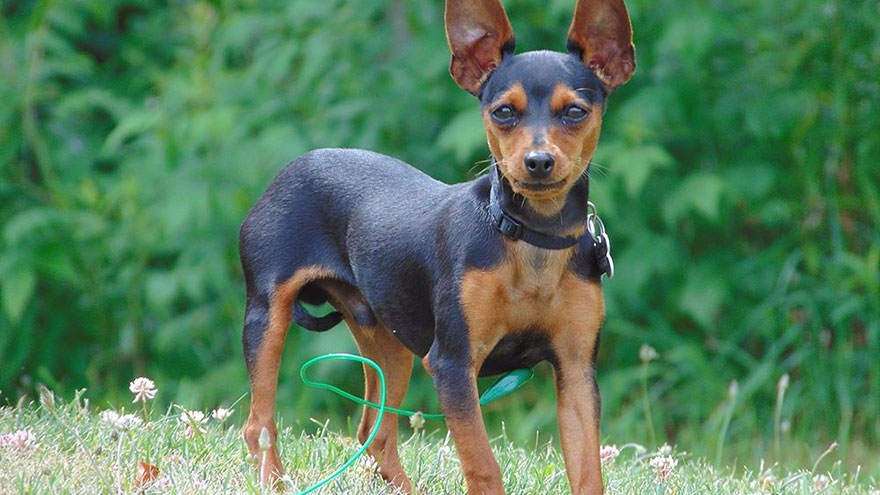Miniature Pinscher : 10 Most Common Questions
The Miniature Pinscher is an interesting breed of dog but do not let its looks fool you. This dog is not just a small version of the well-known Doberman Pinscher. In fact, the Miniature Pinscher is a separate breed with its own spirit, pride, and energy.
Therefore, having this tiny piece of dynamite in the home may take some extra care and attention. However, owners often report that once they have a Miniature Pinscher, they would not have any other kind of pet.
We have put together 10 of the most common questions about this breed with answers for each.

1. What is the history and background of the Miniature Pinscher?
Again, this is not a miniature version of the Doberman or the German pinscher. The Miniature Pinscher was bred specifically from breeds as varied as the dachshund and the Italian Greyhound, and was often seen catching such animals as mice, rats, and other small vermin in the home and outside.
This is actually an older breed than the Doberman, with roots as far back as 200 years.
2. What special activity does the Miniature Pinscher like?
People often enjoy the unstructured energy of this breed, with its spunk and pride. The dog seems to have a sense of humor, responding to the actions and laughter of people who are watching.
With proper training and handling, the Miniature Pinscher can be very good at competitive obedience trials and other shows, but it needs a firm and consistent hand. This dog loves to explore and will “attack” and capture small objects or animals.
3. Does the Miniature Pinscher get along with other dogs?
If you buy a puppy from a good breeder who has taken the time to properly socialize the dog, you will find that your pet gets along with other animals most of the time.
Some adult Miniature Pinschers can be aggressive toward other dogs and will sometimes seem fearless when something suspicious or threatening occurs. Basic obedience training is a must for this breed.
4. What is the best way to housebreak/paper train my Miniature Pinscher?
Different breeders and experienced owners have various methods, but many owners report success with paper training in the house, if the training is consistent. Additionally, training should not interfere with the dog’s playful and sometimes frustrating nature.
Training the dog to go outside works best, as long as you stay on a tight schedule of taking your dog outside several times each day, at the same time every day if possible. This is a very intelligent breed, but the dog can be stubborn and try to outthink you.
5. Does the Miniature Pinscher make a good outside dog?
Not usually considered an outside dog, the Miniature Pinscher will be better as an inside dog, even in an apartment or small home.
However, this breed needs exercise and time to explore in a fenced yard or on a leash. It would be best not to leave your pet tied outside and not to leave it alone for an extended amount of time.
6. Is this a good breed for children?
Generally, the Miniature Pinscher does well with children, but buying a well-bred and properly raised puppy from a good breeder is essential to get a young dog that is comfortable around people.
The Miniature Pinscher does not do well with rough handling and will not tolerate a lot of silly activity. However, this dog is loyal and friendly to those people it knows.
7. How big does this breed get?
The Miniature Pinscher, commonly known as the King of the Toy Dogs, stands about 10 inches to 12 inches at the withers and weighs 8 pounds to 10 pounds.
This breed is a muscular and compact dog that tends to overeat and become obese. For this reason, you need to carefully monitor the dog’s diet and make sure it gets adequate exercise.
8. What health problems should I be aware of with the Miniature Pinscher?
This breed is one of the more healthy breeds, but owners should ask about hereditary conditions such as retinal atrophy and luxating patella (knee problems) when shopping with breeders.
Generally, this breed of dog is clean and healthy, with short, coarse coat that does not present many health problems.
9. Should I keep small toys and chewing items from my Miniature Pinscher?
Yes, it is recommended that you not leave small items such as pens, pencils, small toys, bottle caps, etc. lying around because the Miniature Pinscher will investigate and “attack” these things.
Sometimes, the smaller objects will pose a risk of choking. Therefore, it would be best to give our Miniature Pinscher a larger, chewable item.
10. Is it true that this breed is hard to train?
The Miniature Pinscher can be a challenge to train, because it has lots of pride and can be self-possessed. For instance, your pet may try to bluff you and dominant training sessions unless you are firm and consistent in your demands.
We recommend not going to extremes of spoiling this breed because the dog will take advantage of you if you do. Just remember, this dog does not tolerate rough, harsh treatment either.
Read More About Miniature Pinscher
- Miniature Pinscher Breed Information
- Miniature Pinscher Training Guide
- Miniature Pinscher Health Guide
- Owning a Miniature Pinscher : Breeder Recommendations

